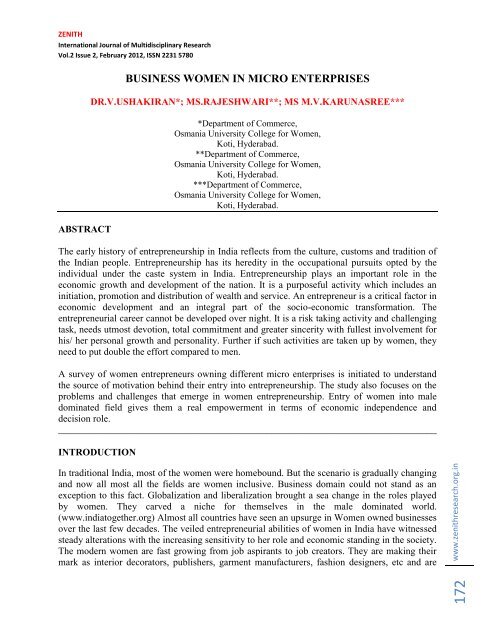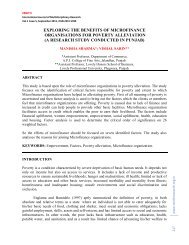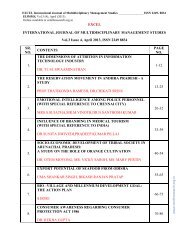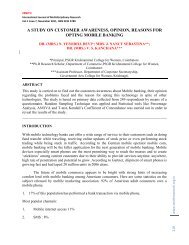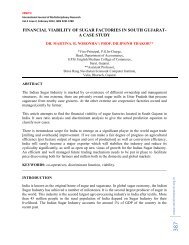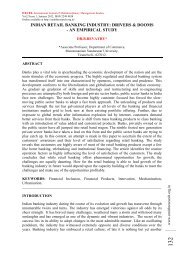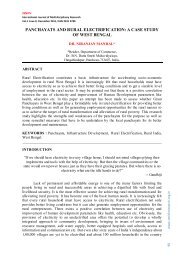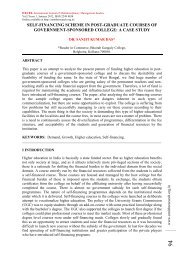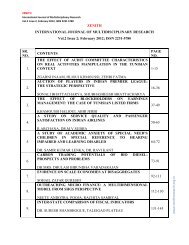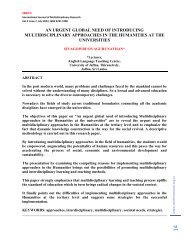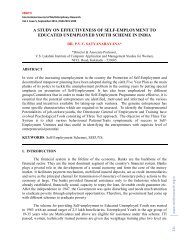business women in micro enterprises - zenith international journal of ...
business women in micro enterprises - zenith international journal of ...
business women in micro enterprises - zenith international journal of ...
You also want an ePaper? Increase the reach of your titles
YUMPU automatically turns print PDFs into web optimized ePapers that Google loves.
174www.<strong>zenith</strong>research.org.<strong>in</strong>ZENITHInternational Journal <strong>of</strong> Multidiscipl<strong>in</strong>ary ResearchVol.2 Issue 2, February 2012, ISSN 2231 5780TABLE-1 PROFILE OF BUSINESS WOMENCharacteristic Number PercentageNature <strong>of</strong> the Bus<strong>in</strong>essServiceRetailFashion Design<strong>in</strong>g and Toy mak<strong>in</strong>gEducation LevelsBelow IntermediateUpto PGExperience as Entrepreneurs (Years)Less than 22-66-10More than 10Hours Dedicated to the Bus<strong>in</strong>ess per day : 9 hoursAverage Age : 39 YearsAverage Turnover : Rs. 3.75 Lakhs183012352517230911305020584228381519Capital Investment : < Rs.5 Lakhs (90%), Rs5lakhs to 20 lakhs (10%)Source : Primary dataThe skills required differ from one <strong>bus<strong>in</strong>ess</strong> to another. Entrepreneurs start a <strong>bus<strong>in</strong>ess</strong> depend<strong>in</strong>gon their skills, abilities and qualifications. Many studies concluded that <strong>women</strong> mostly operate<strong>in</strong> <strong>women</strong> oriented <strong>bus<strong>in</strong>ess</strong>es such as beauty care, tailor<strong>in</strong>g, fashion design<strong>in</strong>g, pickle mak<strong>in</strong>g,textile sell<strong>in</strong>g and so on. Majority <strong>of</strong> the entrepreneurs under study opted to operate <strong>in</strong> servicesector which <strong>in</strong>cluded beauty care, f<strong>in</strong>ance, travels, schools, marriage bureau and gas agency.The retail<strong>in</strong>g sector is also equally appeal<strong>in</strong>g to <strong>bus<strong>in</strong>ess</strong> <strong>women</strong> where <strong>bus<strong>in</strong>ess</strong>es likepharmacy, jaggery trad<strong>in</strong>g, textiles, retail stores and sale <strong>of</strong> Tupperware are be<strong>in</strong>g adopted bythem.
175www.<strong>zenith</strong>research.org.<strong>in</strong>ZENITHInternational Journal <strong>of</strong> Multidiscipl<strong>in</strong>ary ResearchVol.2 Issue 2, February 2012, ISSN 2231 5780Toy Mak<strong>in</strong>g, fashion design<strong>in</strong>g are generally <strong>women</strong> oriented <strong>bus<strong>in</strong>ess</strong>es which require aptitude,creativity and <strong>in</strong>terest towards them rather than educational background. Education givestechnical skills and problem solv<strong>in</strong>g skills. However, certa<strong>in</strong> <strong>bus<strong>in</strong>ess</strong>es do not require theeducational support. It is observed that <strong>women</strong> with lower education i.e., below <strong>in</strong>termediate areequally compet<strong>in</strong>g with those with higher qualifications. It is observed that 58% <strong>of</strong> <strong>bus<strong>in</strong>ess</strong><strong>women</strong> has studied upto Intermediate and 42% upto P.G. Women are very critical when it comesto themselves - can I really do this, am I good enough, maybe I have to learn more, others can doit better. It is quite <strong>in</strong>terest<strong>in</strong>g that many successful <strong>women</strong> have been educated <strong>in</strong> only girlscolleges and schools, which <strong>of</strong>ten deliver a safe environment to try out ones personal strengths,learn to overcome weaknesses and be proud <strong>of</strong> oneself.The <strong>enterprises</strong> under study are basically <strong>micro</strong> <strong>in</strong> nature with capital <strong>in</strong>vestment rang<strong>in</strong>g fromRs.2 lakhs to Rs.20 lakhs. A majority <strong>of</strong> the entrepreneurs (90%) are ma<strong>in</strong>ta<strong>in</strong><strong>in</strong>g an averageturnover <strong>of</strong> below 5 lakhs with others <strong>in</strong> the range <strong>of</strong> Rs. 5 lakhs to Rs.30 lakhs. These<strong>enterprises</strong> are generat<strong>in</strong>g employment to a m<strong>in</strong>imum <strong>of</strong> three and maximum <strong>of</strong> five. They aremanaged by married <strong>women</strong>. The average age <strong>of</strong> the respondents is calculated at 39 years.Their experience as <strong>bus<strong>in</strong>ess</strong> <strong>women</strong> varies from less than 2 years to more than 10 years. 72% <strong>of</strong>the entrepreneurs are found to have more than 2 years <strong>of</strong> experience. They add value to familyas well as <strong>bus<strong>in</strong>ess</strong> by be<strong>in</strong>g devoted to <strong>bus<strong>in</strong>ess</strong> for an average time <strong>of</strong> 9 hours daily.SOURCE OF MOTIVATIONThere are certa<strong>in</strong> driv<strong>in</strong>g forces which decide the decision mak<strong>in</strong>g patterns <strong>of</strong> people. Enter<strong>in</strong>g<strong>in</strong>to <strong>bus<strong>in</strong>ess</strong> is a risky decision which needs an aptitude, courage and determ<strong>in</strong>ation. Theseattributes are either <strong>in</strong>ternally cultivated or groomed by other motivat<strong>in</strong>g personalities.TABLE-2 SOURCE OF MOTIVATIONSource Number PercentageFamily 11 27Friends 09 21Self 21 50Tra<strong>in</strong><strong>in</strong>g 01 02Total 42 100Source : Primary dataIt can be noted that only 42 <strong>women</strong> revealed their source <strong>of</strong> <strong>in</strong>spiration. It is really a noteworthyf<strong>in</strong>d<strong>in</strong>g that 50% <strong>of</strong> them are self motivated followed by gett<strong>in</strong>g motivated by family (26%) andfriends (21%). Some times the tra<strong>in</strong><strong>in</strong>g also helps the people to establish <strong>bus<strong>in</strong>ess</strong>es.
176www.<strong>zenith</strong>research.org.<strong>in</strong>ZENITHInternational Journal <strong>of</strong> Multidiscipl<strong>in</strong>ary ResearchVol.2 Issue 2, February 2012, ISSN 2231 5780PROBLEMS OF WOMEN ENTREPRENEURSThe greatest deterrent to <strong>women</strong> entrepreneurs is that they are <strong>women</strong>. Entrepreneursgenerally face different k<strong>in</strong>ds <strong>of</strong> problems such as f<strong>in</strong>ance, management, technical,entrepreneurial, market<strong>in</strong>g and account<strong>in</strong>g. These problems assume more seriousness <strong>in</strong> case <strong>of</strong><strong>women</strong> entrepreneurs as they face gender discrim<strong>in</strong>ation while solv<strong>in</strong>g them. In addition,<strong>women</strong> have to face social barriers and family problems. A k<strong>in</strong>d <strong>of</strong> patriarchal – male dom<strong>in</strong>antsocial order is the build<strong>in</strong>g block to them <strong>in</strong> their way towards <strong>bus<strong>in</strong>ess</strong> success. The malemembers th<strong>in</strong>k that f<strong>in</strong>anc<strong>in</strong>g the ventures run by <strong>women</strong> is a big risk.I. FINANCIAL PROBLEMSThe f<strong>in</strong>ancial <strong>in</strong>stitutions are skeptical about the entrepreneurial abilities <strong>of</strong> <strong>women</strong>. The bankersconsider <strong>women</strong> loonies as higher risk than men loonies. The bankers put unrealistic andunreasonable securities to get loan to <strong>women</strong> entrepreneurs. Accord<strong>in</strong>g to a report by the UnitedNations Industrial Development Organization (UNIDO), despite evidence that <strong>women</strong>'s loanrepayment rates are higher than men's, <strong>women</strong> still face more difficulties <strong>in</strong> obta<strong>in</strong><strong>in</strong>g credit,<strong>of</strong>ten due to discrim<strong>in</strong>atory attitudes <strong>of</strong> banks and <strong>in</strong>formal lend<strong>in</strong>g groups (UNIDO, 1995b).Entrepreneurs usually require f<strong>in</strong>ancial assistance <strong>of</strong> some k<strong>in</strong>d to launch their ventures - be it aformal bank loan or money from a sav<strong>in</strong>gs account. Women <strong>in</strong> develop<strong>in</strong>g nations have littleaccess to funds, due to the fact that they are concentrated <strong>in</strong> poor rural communities with fewopportunities to borrow money (Starcher, 1996; UNIDO, 1995a). The <strong>women</strong> entrepreneurs aresuffer<strong>in</strong>g from <strong>in</strong>adequate f<strong>in</strong>ancial resources and work<strong>in</strong>g capital. The <strong>women</strong> entrepreneurslack access to external funds due to their <strong>in</strong>ability to provide tangible security. Very few <strong>women</strong>have the tangible property <strong>in</strong> hand.The f<strong>in</strong>ancial <strong>in</strong>stitutions discourage <strong>women</strong> entrepreneurs on the belief that they can at any timeleave their <strong>bus<strong>in</strong>ess</strong> and become housewives aga<strong>in</strong>. The result is that they are forced to rely ontheir own sav<strong>in</strong>gs, and loan from relatives and family friendsIt is observed that 86% have reported fac<strong>in</strong>g f<strong>in</strong>ancial problems. The problems identified underthis category are work<strong>in</strong>g capital, sanction<strong>in</strong>g <strong>of</strong> loan, disbursement <strong>of</strong> loan, management <strong>of</strong>f<strong>in</strong>ance, complicated procedure <strong>of</strong> bank loan, delay <strong>in</strong> gett<strong>in</strong>g loan, reimbursement <strong>of</strong> loan andlack <strong>of</strong> guarantee. Inadequate work<strong>in</strong>g capital is reported by majority (50%) <strong>of</strong> them followed bycomplicated procedure <strong>of</strong> bank loan.II. MANAGEMENT PROBLEMSThe management problems generally faced by entrepreneurs are plann<strong>in</strong>g, organiz<strong>in</strong>g,coord<strong>in</strong>at<strong>in</strong>g, and controll<strong>in</strong>g. N<strong>in</strong>ety percent <strong>of</strong> the entrepreneurs reported to have faced all mostall these problems. The major problems identified are plann<strong>in</strong>g the <strong>bus<strong>in</strong>ess</strong> (62%), organiz<strong>in</strong>gthe <strong>bus<strong>in</strong>ess</strong> (22%) and coord<strong>in</strong>at<strong>in</strong>g and controll<strong>in</strong>g (16%).
177www.<strong>zenith</strong>research.org.<strong>in</strong>ZENITHInternational Journal <strong>of</strong> Multidiscipl<strong>in</strong>ary ResearchVol.2 Issue 2, February 2012, ISSN 2231 5780III. TECHNICAL PROBLEMSThe technical problems <strong>of</strong> the entrepreneurs <strong>in</strong>clude old and obsolete method <strong>of</strong> production, lack<strong>of</strong> adequate tra<strong>in</strong><strong>in</strong>g, upgrad<strong>in</strong>g <strong>of</strong> the skills, little design<strong>in</strong>g skills, lack <strong>of</strong> skilled workers,modern mach<strong>in</strong>eries, ideas and time to develop the product, research facilities and low budgetson research development. Knowledge <strong>of</strong> latest technological changes, know how, and educationlevel <strong>of</strong> the person are significant factor that affect <strong>bus<strong>in</strong>ess</strong>. The literacy rate <strong>of</strong> <strong>women</strong> <strong>in</strong> Indiais found at low level compared to male population. Many <strong>women</strong> <strong>in</strong> develop<strong>in</strong>g nations lack theeducation needed to spur successful entrepreneurship. They are ignorant <strong>of</strong> new technologies orunskilled <strong>in</strong> their use, and <strong>of</strong>ten unable to do research and ga<strong>in</strong> the necessary tra<strong>in</strong><strong>in</strong>g (UNIDO,1995b, p.1). Although great advances are be<strong>in</strong>g made <strong>in</strong> technology, many <strong>women</strong>'s illiteracy,strucutural difficulties, and lack <strong>of</strong> access to technical tra<strong>in</strong><strong>in</strong>g prevent the technology from be<strong>in</strong>gbeneficial or even available to females ("Women Entrepreneurs <strong>in</strong> Poorest Countries," 2001).Accord<strong>in</strong>g to The Economist, this lack <strong>of</strong> knowledge and the cont<strong>in</strong>u<strong>in</strong>g treatment <strong>of</strong> <strong>women</strong> assecond-class citizens keeps them <strong>in</strong> a pervasive cycle <strong>of</strong> poverty ("The Female Poverty Trap,"2001). The studies <strong>in</strong>dicates that uneducated <strong>women</strong> donot have the knowledge <strong>of</strong> measurementand basic account<strong>in</strong>g. The respondents reported that gett<strong>in</strong>g skilled workers and upgrad<strong>in</strong>g theirown skills are major problems.IV. ENTREPRENEURIAL PROBLEMSEntrepreneurial problems <strong>in</strong>clude lack <strong>of</strong> experience, lack <strong>of</strong> tra<strong>in</strong><strong>in</strong>g, <strong>in</strong>convenience <strong>in</strong>procur<strong>in</strong>g raw material, low pr<strong>of</strong>its, f<strong>in</strong>ancial problem, low risk tak<strong>in</strong>g attitude, complicated tradelicense procedures, lower participation <strong>in</strong> trade fair, no access to bank loans and f<strong>in</strong>ancial<strong>in</strong>stitutions, no membership with the chamber <strong>of</strong> commerce, missed pr<strong>of</strong>itable orders and buyers,<strong>in</strong>accessibility to export and import related sectors. Knowledge <strong>of</strong> alternative source <strong>of</strong> rawmaterials availability and high negotiation skills are the basic requirement to run a <strong>bus<strong>in</strong>ess</strong>.Gett<strong>in</strong>g the raw materials from different source with discount prices is the factor that determ<strong>in</strong>esthe pr<strong>of</strong>it marg<strong>in</strong>. Lack <strong>of</strong> knowledge <strong>of</strong> availability <strong>of</strong> the raw materials and low-levelnegotiation and barga<strong>in</strong><strong>in</strong>g skills are the factors, which affect <strong>women</strong> entrepreneur's <strong>bus<strong>in</strong>ess</strong>adventures. Twenty four percent <strong>of</strong> <strong>women</strong> expressed that they face the export and import relatedproblems. . Low-level risk tak<strong>in</strong>g attitude is another factor affect<strong>in</strong>g <strong>women</strong> folk decision to get<strong>in</strong>to <strong>bus<strong>in</strong>ess</strong>. Low-level education provides low-level self-confidence and self-reliance to the<strong>women</strong> folk to engage <strong>in</strong> <strong>bus<strong>in</strong>ess</strong>, which is cont<strong>in</strong>uous risk tak<strong>in</strong>g and strategic cession mak<strong>in</strong>gpr<strong>of</strong>ession. Invest<strong>in</strong>g money, ma<strong>in</strong>ta<strong>in</strong><strong>in</strong>g the operations and plough<strong>in</strong>g back money for surplusgeneration requires high risk tak<strong>in</strong>g attitude, courage and confidence. Though the risk toleranceability <strong>of</strong> the <strong>women</strong> folk <strong>in</strong> day-to-day life is high compared to male members, while <strong>in</strong><strong>bus<strong>in</strong>ess</strong> it is found opposite to that. Low risk tak<strong>in</strong>g attitude (46%) and f<strong>in</strong>ancial problems(52%) are identified as entrepreneurial risks.V. GOVERNMENT SUPPORTBoth Central and State governments are implement<strong>in</strong>g various assistance, schemes for thepromotion <strong>of</strong> <strong>women</strong> entrepreneurship. But <strong>in</strong> practice the respondents face many difficulties <strong>in</strong>obta<strong>in</strong><strong>in</strong>g government assistance due redtapism at various levels, exploitative advisors, problems
178www.<strong>zenith</strong>research.org.<strong>in</strong>ZENITHInternational Journal <strong>of</strong> Multidiscipl<strong>in</strong>ary ResearchVol.2 Issue 2, February 2012, ISSN 2231 5780due to dishonest <strong>of</strong>ficials, complicated and time consum<strong>in</strong>g long procedures <strong>in</strong> gett<strong>in</strong>g theassistance, etc.Government extends support to <strong>women</strong> entrepreneurs <strong>in</strong> the form <strong>of</strong> priority loan lend<strong>in</strong>g,concessional <strong>in</strong>terest, specially designed schemes, tra<strong>in</strong><strong>in</strong>g facilities, tax concessions and so on.Majority <strong>of</strong> the entrepreneurs (82%) reported lack <strong>of</strong> government support as a problem while44% <strong>of</strong> the entrepreneurs expressed that they lack knowledge about concessions <strong>of</strong>fered by thegovernment where as 23% reported that they do not know any <strong>in</strong>formation about taxconcessions.VI. MARKETING PROBLEMSAnother argument is that <strong>women</strong> entrepreneurs have low-level management skills. They have todepend on <strong>of</strong>fice staffs and <strong>in</strong>termediaries, to get th<strong>in</strong>gs done, especially, the market<strong>in</strong>g and salesside <strong>of</strong> <strong>bus<strong>in</strong>ess</strong>. Here there is more probability for <strong>bus<strong>in</strong>ess</strong> fallacies like the <strong>in</strong>termediaries takemajor part <strong>of</strong> the surplus or pr<strong>of</strong>it. Market<strong>in</strong>g means mobility and confidence <strong>in</strong> deal<strong>in</strong>g with theexternal world, both <strong>of</strong> which <strong>women</strong> have been discouraged from develop<strong>in</strong>g by socialcondition<strong>in</strong>g. Even when they are otherwise <strong>in</strong> control <strong>of</strong> an enterprise, they <strong>of</strong>ten depend onmales <strong>of</strong> the family <strong>in</strong> this area.Acceptance <strong>of</strong> product, lack <strong>of</strong> barga<strong>in</strong><strong>in</strong>g skills, publicity, market <strong>in</strong>formation, supportivenetwork and proper tra<strong>in</strong><strong>in</strong>g, no accessibility to foreign market are major market<strong>in</strong>g problems.All the entrepreneurs felt that market<strong>in</strong>g is the major problem. Miss<strong>in</strong>g networks - throughcenturies <strong>bus<strong>in</strong>ess</strong> men have build up their networks but <strong>women</strong> still have to learn to catch up31% reported that lack <strong>of</strong> publicity is caus<strong>in</strong>g great problem, 18% compla<strong>in</strong>ed that right price isnot received by them because <strong>of</strong> their lack <strong>of</strong> barga<strong>in</strong><strong>in</strong>g skills while sell<strong>in</strong>g and purchas<strong>in</strong>g.VII. SOCIAL BARRIERSFamily restrictions and religious belief and traditional customs are the social barriers. Indian<strong>women</strong> give more emphasis to family ties and relationships. Married <strong>women</strong> have to make a f<strong>in</strong>ebalance between <strong>bus<strong>in</strong>ess</strong> and home. More over the <strong>bus<strong>in</strong>ess</strong> success is depends on the supportthe family members extended to <strong>women</strong> <strong>in</strong> the <strong>bus<strong>in</strong>ess</strong> process and management. The <strong>in</strong>terest <strong>of</strong>the family members is a determ<strong>in</strong>ant factor <strong>in</strong> the realization <strong>of</strong> <strong>women</strong> folk <strong>bus<strong>in</strong>ess</strong> aspirations.The study reveals that 50% <strong>of</strong> <strong>women</strong> entrepreneurs do not face any social barriers. However, itis found that 30% <strong>of</strong> them suffer from family restrictions and 20% reported problems on account<strong>of</strong> religious beliefs and traditional customs.VIII. ACCOUNTING PROBLEMSMa<strong>in</strong>ta<strong>in</strong><strong>in</strong>g books <strong>of</strong> accounts, computerization <strong>of</strong> account<strong>in</strong>g, lack <strong>of</strong> knowledge and approachto a pr<strong>of</strong>essional accountant are the account<strong>in</strong>g problems. 87% <strong>of</strong> the <strong>women</strong> entrepreneurs feltthat ma<strong>in</strong>ta<strong>in</strong><strong>in</strong>g books <strong>of</strong> accounts is the biggest problem while 36% reported that they do nothave knowledge <strong>of</strong> account<strong>in</strong>g and 11% felt that non computerization <strong>of</strong> accounts has become aproblem.
179www.<strong>zenith</strong>research.org.<strong>in</strong>ZENITHInternational Journal <strong>of</strong> Multidiscipl<strong>in</strong>ary ResearchVol.2 Issue 2, February 2012, ISSN 2231 5780IX. FAMILY PROBLEMSLess time for the family, children education and personal hobbies, lack <strong>of</strong> support from familymembers are the major family problems faced by <strong>women</strong> entrepreneurs.It is clear, that <strong>women</strong> have the responsibility <strong>of</strong> gett<strong>in</strong>g children and tak<strong>in</strong>g care <strong>of</strong> them. Veryfew societies accept fathers tak<strong>in</strong>g over the role <strong>of</strong> stay<strong>in</strong>g home and tak<strong>in</strong>g care <strong>of</strong> the children.Once these children are old enough to take care for themselves, they have to bear an additionalresponsibility <strong>of</strong> tak<strong>in</strong>g care <strong>of</strong> elder parents. If they want to become entrepreneurs, the societyexpects them to be able to do both: take care <strong>of</strong> family and home and do <strong>bus<strong>in</strong>ess</strong>. 93% <strong>women</strong>entrepreneurs reported that family life and work life blend becomes a problem. They felt thatthey are not able to spend enough time with family (39%), concentrate on children’s education(30%)and have lack <strong>of</strong> support from family (11%) and less time for personal hobbies andrelations (7%).X. DISCRIMINATIONDiscrim<strong>in</strong>ation - The male - female competition is another factor, which develop hurdles to<strong>women</strong> entrepreneurs <strong>in</strong> the <strong>bus<strong>in</strong>ess</strong> management process. Despite the fact that <strong>women</strong>entrepreneurs are good <strong>in</strong> keep<strong>in</strong>g their service prompt and delivery <strong>in</strong> time, due to lack <strong>of</strong>organisational skills compared to male entrepreneurs <strong>women</strong> have to face constra<strong>in</strong>ts fromcompetition. The confidence to travel across day and night and even different regions and statesare less found <strong>in</strong> <strong>women</strong> compared to male entrepreneurs. This shows the low level freedom <strong>of</strong>expression and freedom <strong>of</strong> mobility <strong>of</strong> the <strong>women</strong> entrepreneurs. It is hard to believe but <strong>women</strong>are still treated differently <strong>in</strong> our society. Women do get lower salaries compared to men do<strong>in</strong>gthe same job, <strong>women</strong> do not have access to men dom<strong>in</strong>ated networks who take their decisionsabout successors.Discrim<strong>in</strong>ation <strong>in</strong> <strong>bus<strong>in</strong>ess</strong> may arise due to gender, caste and education, etc. It is observed thatonly 42% <strong>of</strong> <strong>women</strong> entrepreneurs reported discrim<strong>in</strong>ation. Further, it is observed thatdiscrim<strong>in</strong>ation on account <strong>of</strong> education is faced by 19% followed by gender (16%) and caste(6%). It can be concluded that gender discrim<strong>in</strong>ation is not a major problem and <strong>women</strong> canovercome it very easily.ADVICE OR CONSULTANCY AND SUPPORTA question was posed to <strong>women</strong> entrepreneurs whether they require any consultancy <strong>in</strong> the area<strong>of</strong> f<strong>in</strong>ance, taxation, technical, legal or account<strong>in</strong>g. It was found that 10% do not require anyconsultancy whereas 50% <strong>of</strong> them wanted f<strong>in</strong>ancial advice. Technical advice is sought by 25%,whereas 10% require legal advice. Therefore government should create a s<strong>in</strong>gle w<strong>in</strong>dow throughwhich the entrepreneurs are given consultancy <strong>in</strong> various areas while enter<strong>in</strong>g <strong>in</strong>to <strong>bus<strong>in</strong>ess</strong> andeven dur<strong>in</strong>g the runn<strong>in</strong>g <strong>of</strong> <strong>bus<strong>in</strong>ess</strong>. All <strong>women</strong> entrepreneurs unanimously agreed that theirorganizations will be successful only then they get support from government, f<strong>in</strong>ancial<strong>in</strong>stitutions, tra<strong>in</strong><strong>in</strong>g <strong>in</strong>stitutions, trade associations and family.
180www.<strong>zenith</strong>research.org.<strong>in</strong>ZENITHInternational Journal <strong>of</strong> Multidiscipl<strong>in</strong>ary ResearchVol.2 Issue 2, February 2012, ISSN 2231 5780EMERGING CHALLENGES IN WOMEN ENTREPRENEURSHIPVarious challenges emerge <strong>in</strong> entrepreneurship and the art <strong>of</strong> entrepreneurship lies <strong>in</strong> manag<strong>in</strong>gthem. The respondents identified competition (39%), lack <strong>of</strong> capital (34%), accessibility tomarket (20%), lack <strong>of</strong> specific <strong>in</strong>formation and high cost <strong>of</strong> production (7%) as major challenges.CONCLUSIONIrrespective <strong>of</strong> the problems and challenges that emerge <strong>in</strong> the process <strong>of</strong> entrepreneur ship,<strong>women</strong> are go<strong>in</strong>g ahead <strong>in</strong> the <strong>bus<strong>in</strong>ess</strong> doma<strong>in</strong>. Their entry <strong>in</strong>to this male dom<strong>in</strong>ated world isdef<strong>in</strong>itely br<strong>in</strong>g<strong>in</strong>g a fresh air as they can add valuable <strong>in</strong>novation to entrepreneurship. Their<strong>in</strong>nate mental flexibility, vision for long-term plann<strong>in</strong>g, patient attitude, s<strong>in</strong>cerity and the abilityto tolerate ambiguity and changes are a valuable asset for <strong>bus<strong>in</strong>ess</strong> ventures. The Governmentand other f<strong>in</strong>ancial <strong>in</strong>stitutions should enhance support lend<strong>in</strong>g activities to these <strong>women</strong>thorough s<strong>in</strong>gle w<strong>in</strong>dow schemes. More awareness camps have to be conducted. Educational<strong>in</strong>stitutes too need to <strong>in</strong>culcate the entrepreneurial skills <strong>in</strong> the <strong>women</strong>. All the players <strong>in</strong> the fieldshould understand that motivation and environmental demography plays a crucial role <strong>in</strong> the<strong>in</strong>creased <strong>women</strong> entrepreneurship activity.REFERENCES1. Aida Idris, A pr<strong>of</strong>ile <strong>of</strong> the <strong>in</strong>novative <strong>women</strong> entrepreneurs, April 2008, Vol I No-2International Bus<strong>in</strong>ess Research2. Bharathi Kollan and Indira J Parekh, A refection on the Indian Women on theentrepreneurial world, WPno2005- 08-07August 2005.IIMA Work<strong>in</strong>g Series3. Bharathi N., Women entrepreneurs: Motivational factors and Problems, Asia PacificBus<strong>in</strong>ess Review, Jan – March 20094. Dileep Kumar M., Problems <strong>of</strong> Women Entrepreneurs <strong>in</strong> India, www. Indianmba.com.5. Kavitha Raman, Anantharaman, R.N. and Sharmila Jayas<strong>in</strong>gam, Affect<strong>in</strong>gEntrepreneurial Decision: A Comparison between Malaysian Women Entrepreneurs andWomen Non Entrepreneurs, www. Ibima publish<strong>in</strong>g.com6. Suganthi .J, Influence <strong>of</strong> motivational factors on <strong>women</strong> entrepreneurs <strong>in</strong> SMEs, AsiaPacific Bus<strong>in</strong>ess Review, Jan – March 2009.7. Sur<strong>in</strong>derS<strong>in</strong>gh, An <strong>in</strong>sight <strong>in</strong>to the emergence <strong>of</strong> <strong>women</strong> owned <strong>bus<strong>in</strong>ess</strong>es as economicforce <strong>in</strong> India, ez<strong>in</strong>articles.com


